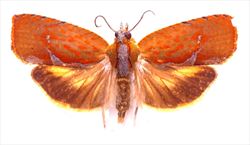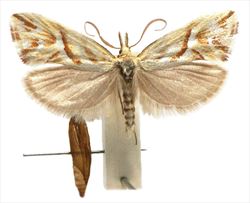OF BIOSECURITY CONCERN
Tortricoidea
Tortricidae (leaf tiers, borers, detritivous feeders) 10,387 approximate described species
Cosmopolitan particularly the Old World tropics
Grapes, apples, raspberries, blackberries, apricots, avocadoes, Citrus, carnations, Pinus, pineapples, sugarcane, Gramineae
The female ovipositor is the single apomorphy that unites the entire family.
Head rough-scaled, scaling of lower frons short, appressed and upwardly directed; labial palpi three-segmented and generally held horizontally or porrect, with apical segment short and blunt; maxillary palpi reduced; ovipositor lobes flat. (Horak 2006).
Tortricinae – cubital pecten absent – contains species of biosecurity concern
Olethreutinae – cubital pecten present – contains species of biosecurity concern
Chlidanotinae – cubital pectin absent – not a biosecurity target group
Atlas of Living Australia. National Research Infrastructure for Australia, NCRIS. http://www.ala.org.au/
ABRS 2009. Australian Faunal Directory. Australian Biological Resources Study, Canberra. http://www.environment.gov.au/biodiversity/abrs/online-resources/fauna/afd/index.html
Butterflies and moths of North America, collecting and sharing data about Lepidoptera. National Biological Information Infrastructure (NBII) Program and the USGS Northern Prairie Wildlife Research Center. http://butterfliesofamerica.com/links.htm
CSIRO Australian National Insect Collection Database. http://anic.ento.csiro.au/database/
CSIRO Ecosystem Sciences. Australian Moths Online. http://www1.ala.org.au/gallery2/main.php
Herbison-Evans D, Crossley S. Families of Moths in Australia. http://lepidoptera.butterflyhouse.com.au/moths.html
Gilligan TM. Tortricid.net Tortricidae Resources on the Web, version 2.0. Last accessed June 2015. http://www.tortricidae.com/
Gilligan TM, Epstein ME. TortAI Torticids of Agricultural Importance, last accessed June 2015. http://idtools.org/id/leps/tortai
Holloway JD, Kibby G, Djunijanti P (2001) The families of Malesian moths and butterflies, Fauna Malesiana handbook 3, The Netherlands.
iBol Terrestrial Biosurveillance, Lepidoptera barcode of life. http://www.lepbarcoding.org/
Natural History Museum, The Global Lepidoptera Names Index. http://www.nhm.ac.uk/research-curation/research/projects/lepindex/search/index.dsml
Plant Health Australia (2012) Combined High Priority Pest List from Industry Biosecurity Plans. In National Plant Biosecurity Status Report, last accessed June 2015. http://www.planthealthaustralia.com.au/biosecurity/emergency-plant-pests/pest-categorisation/categorised-pests/
Robinson GS, Ackery PR, Kitching IJ, Beccaloni GW, Hernández LM (2001) Hostplants of the moth and butterfly caterpillars of the Oriental Region, The Natural History Museum, London.
The Barcode of Life Data Systems http://www.boldsystems.org/
Common IFB (1990) In Moths of Australia, Melbourne University Press, Carlton, Victoria.
Horak M (2006) Olethreutine moths of Australia (Lepidoptera: Tortricidae). Monographs on Australian Lepidoptera, Vol 10.
Kristensen NP (ed) (1999) Lepidoptera, Moths and Butterflies: Evolution, Systematics and Biogeography (vol. 1). Handbook of Zoology, Walter de Gruyter, Berlin.
Northern Australia Quarantine Strategy (2015) Entomology Internal Target List. Australian Government Department of Agriculture.
Operational Science Program (2015) Entomology Internal Target List. Australian Government Department of Agriculture.
Plant Health Australia (2012) Combined High Priority Pest List from Industry Biosecurity Plans. In National Plant Biosecurity Status Report, last accessed June 2015. http://www.planthealthaustralia.com.au/biosecurity/emergency-plant-pests/pest-categorisation/categorised-pests/
van Nieukerken EJ, Kaila L, Kitching IJ, Kristensen NP, Lees DC, et al. (2011) Order Lepidoptera Linnaeus, 1758. In Zhang, Z.-Q. (Ed.) Animal Biodiversity: An outline of higher level classification and survey of taxonomic richness. Order Lepidoptera Linnaeus, 1758. Zootaxa. 3148: 212–221.

